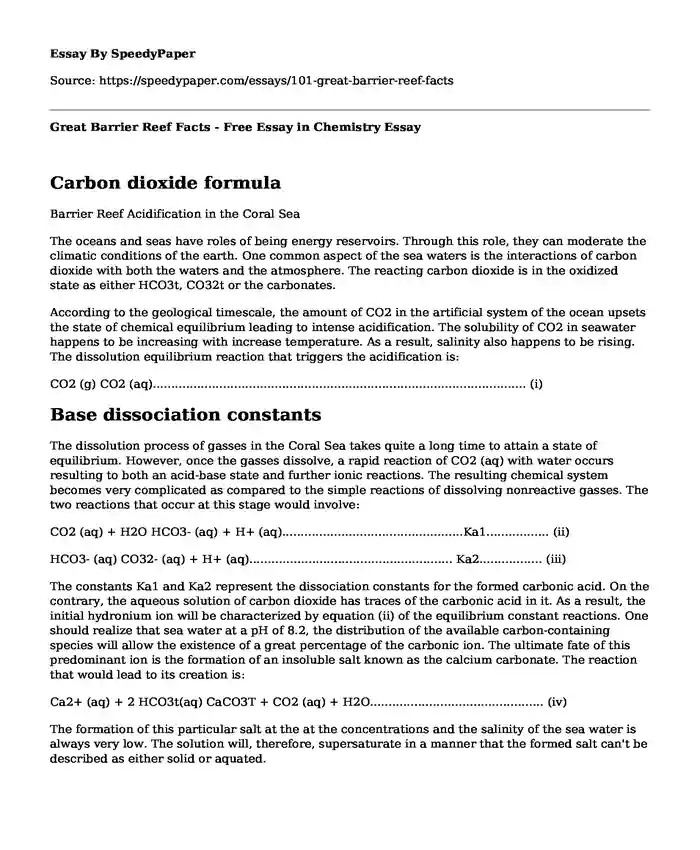Carbon dioxide formula
Barrier Reef Acidification in the Coral Sea
The oceans and seas have roles of being energy reservoirs. Through this role, they can moderate the climatic conditions of the earth. One common aspect of the sea waters is the interactions of carbon dioxide with both the waters and the atmosphere. The reacting carbon dioxide is in the oxidized state as either HCO3t, CO32t or the carbonates.
According to the geological timescale, the amount of CO2 in the artificial system of the ocean upsets the state of chemical equilibrium leading to intense acidification. The solubility of CO2 in seawater happens to be increasing with increase temperature. As a result, salinity also happens to be rising. The dissolution equilibrium reaction that triggers the acidification is:
CO2 (g) CO2 (aq)..................................................................................................... (i)
Base dissociation constants
The dissolution process of gasses in the Coral Sea takes quite a long time to attain a state of equilibrium. However, once the gasses dissolve, a rapid reaction of CO2 (aq) with water occurs resulting to both an acid-base state and further ionic reactions. The resulting chemical system becomes very complicated as compared to the simple reactions of dissolving nonreactive gasses. The two reactions that occur at this stage would involve:
CO2 (aq) + H2O HCO3- (aq) + H+ (aq).................................................Ka1................. (ii)
HCO3- (aq) CO32- (aq) + H+ (aq)....................................................... Ka2................. (iii)
The constants Ka1 and Ka2 represent the dissociation constants for the formed carbonic acid. On the contrary, the aqueous solution of carbon dioxide has traces of the carbonic acid in it. As a result, the initial hydronium ion will be characterized by equation (ii) of the equilibrium constant reactions. One should realize that sea water at a pH of 8.2, the distribution of the available carbon-containing species will allow the existence of a great percentage of the carbonic ion. The ultimate fate of this predominant ion is the formation of an insoluble salt known as the calcium carbonate. The reaction that would lead to its creation is:
Ca2+ (aq) + 2 HCO3t(aq) CaCO3T + CO2 (aq) + H2O............................................... (iv)
The formation of this particular salt at the at the concentrations and the salinity of the sea water is always very low. The solution will, therefore, supersaturate in a manner that the formed salt can't be described as either solid or aquated.
Le chatelier principle
Consider the fact that as the level of atmospheric carbon dioxide in reaction (i) increases, the Le Chatelier Principle deduces that the amount of sea carbon dioxide increases as well. On the contrary, the same principle as applied in reaction (ii) shows that if the amount of aquated carbon dioxide increases, the forward reaction is favored thus the concentrations of both HCO3t(aq) and H+(aq) are increased. On the fourth result, the Le Chatelier Principle applied portrays that increasing the amount of CO2 (aq) favors the reverse reaction thus increasing the concentrations of both Ca2+ (aq) and HCO3t(aq). Since CO2 (aq) is acidic, it will react with the predominant base in significant concentrations thus upsetting the buffer system. The resulting reaction would be:
CO2 (aq) + CO32t (aq) + H2O 2 HCO3t (aq)......................................................... (v)
The overall results of such equilibrium concentration shifts are the increase of H+ (aq), meaning more acidity of the sea water. The observations made would include reduction of the pH of the upper layer of the waters by about 0.1. With an increasing amount of carbon dioxide dissolving, the concentration of the waters will shift, and the effects of such changes will be evident.
Reference
Society, American Chemical.T Ocean chemistry - American Chemical society. American Chemical Society, 2017. Www.Acs.Org/content/acs/en/climatescience/oceansicerocks/oceanchemistry.Html. 4 Mar. 2017.
MarineBio.T Ocean chemistry. 1998. Viewed on 4 Mar. 2017. Www.Marinebio.Org/oceans/ocean-chemistry
Cite this page
Great Barrier Reef Facts - Free Essay in Chemistry. (2018, May 08). Retrieved from https://speedypaper.com/essays/101-great-barrier-reef-facts
Request Removal
If you are the original author of this essay and no longer wish to have it published on the SpeedyPaper website, please click below to request its removal:
- Essay Example on Music Therapy Case Study
- The Thinking about Conformity - Free Essay Sample
- Traits of a Scholar, Free Essay Example
- Essay Sample with Characters Analysis of The Great Gatsby Novel
- The Impacts of Social Darwinism, Free Essay
- Aristotle's Four Causes Essay Sample
- Essay Sample: A Response to George F. Holmes Review of Uncle Tom's Cabin
Popular categories





